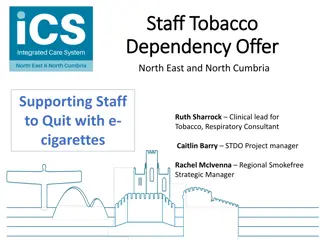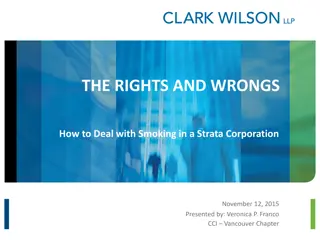The Impact of Cigarette Taxes and Indoor Air Laws on Prenatal Smoking and Infant Death
This study examines the effects of cigarette taxes and indoor air laws on prenatal smoking and infant death. It discusses how cigarette taxes can increase smoking cessation during pregnancy and reduce the probability of smoking, while comprehensive smoking bans can decrease the likelihood of smoking in households with children. Furthermore, evidence indicates a relationship between cigarette taxes and infant death, with higher taxes during pregnancy associated with a decrease in infant mortality rates.
Download Presentation

Please find below an Image/Link to download the presentation.
The content on the website is provided AS IS for your information and personal use only. It may not be sold, licensed, or shared on other websites without obtaining consent from the author. Download presentation by click this link. If you encounter any issues during the download, it is possible that the publisher has removed the file from their server.
E N D
Presentation Transcript
THE EFFECT OF CIGARETTE TAXES AND INDOOR AIR LAWS ON PRENATAL SMOKING AND INFANT DEATH Authors: Max Chomas and Mike Pesko Presenter: Max Chomas
DISCLOSURE I am a graduate student and have no current or historical funding.
TOBACCO REGULATION AND PRENATAL SMOKING Cigarette taxes increase smoking cessation during pregnancy (Coleman et. al. 2003, Adams et. al. 2012, Harris et. al. 2015) Cigarette taxes also reduce the probability of smoking during pregnancy (Evans and Ringel 1999, Lien and Evans 2005, Simon 2016, Friedson and Rees 2020) Some evidence that comprehensive smoking bans can decrease the probability of an adult smoking inside a household with kids (McGeary et. al. 2017)
TOBACCO REGULATION AND INFANT DEATH Evidence that there is a relationship between cigarette taxes and infant death (Markowitz 2008 , Sen and Pierard 2011, King et. al. 2014, Patrick et. al. 2016) Increase cigarette taxes during pregnancy decrease probability/incidence of infant death. Markowitz (2008) studies how cigarette taxes and indoor smoking bans affect SIDS (Sudden Infant Death Syndrome) incidence from 1973-2003 in USA using a two-way fixed effect model. 10% increase in cigarette tax 7% less SIDS cases Comprehensive smoking bans in work places decrease SIDS counts.
RESEARCH QUESTION Maternal smoking pre- and post-partum can cause infant death through many channels (U.S. Department of Health and Human Services 2014) Second-hand smoke, preterm delivery, low birth weight etc. Infant death within 28 days after birth is 20% more likely if the infant s mother smoked (Cnattingius et al. 1988) Question: Can making smoking more expensive/inconvenient decrease prenatal smoking and the probability of infant death? 1. Making smoking more expensive through cigarette taxes or inconvenient through forcing people to go outside to smoke may reduce prenatal smoking. 2. Infant mortality could be affected by changes in prenatal smoking, post-natal smoking, other second-hand smoke exposure, and possibly even compensatory strategies to avoid the policies.
CONTRIBUTION Extend Markowitz and previous studies by: 1. Looking at all forms of infant death (SIDS comprises 6.3% of infant deaths) Today we ll focus on just SIDS. 2. Study a recent time period (2000-2018) 3. Use a stacked difference-in-differences (DD) model (Cengiz et. al. 2019) to lessen problems with traditional staggered difference-in-differences (Goodman-Bacon 2021).
DATA American Non-Smokers Right s Foundation (ANRF): 2000-2018 Provides data on indoor air law and cigarette taxes all the way down to the city level. State and local cigarette tax data used to create a population-weighted state-level tax. Use indoor air law information to construct an index from 0-1 for the percent of the state population covered: Uses 3 venues (workplaces, bars, and restaurants), each venue weighted equally. Partial bans (such as in designated areas only) receive only weight. Examples: State A has a state-wide ban in restaurants and bars, no other local laws. 67% coverage. State B has no state law but a city with 20% of the population has a total ban in all three venues. 20% coverage.
DATA CDC s National Vital Statistics System: 2000-2018 Administrative data of nearly all births in the USA Provides state and county geocodes, and demographic information on mother such as race, marital status, education, number of previous births, etc. Linked Birth/Infant Death Period Data Death certificate data linked to births if the birth and death occur in the same calendar year. Captures approximately 86% of first-year infant death Provides additional information on timing and cause of infant death
METHODOLOGY DD requires a treatment group (a state where the policy was implemented) and a control group (a state with no policy change around the effective date of the treated state). To estimate a stacked DD model, we do the following (separately for taxes and indoor air laws): 1. Identify isolated policy changes ( event ) with no other change occurring four years before and three years after. 2. Only keep states that were in the top 50% of policy changes. Used in minimum wage literature (Clemens and Strain, 2021) We should expect higher changes in policy level to have a larger impact than lower changes in policy level. 3. For each event, select control states if the policy had not changed in the same 7 year window. States that were treated (in our definition) earlier cannot be used as controls later. 4. Each event and control states make up a stack. 5. Append the stacks, creating one dataset for the tax events and one dataset for the indoor air law events.
METHODOLOGY By assembling these 2 data sets in this way (particularly the control group), we mitigate the problem of treated units returning as controls for later treated units (Goodman-Bacon 2021). We also put every event into period time . Policy changes for an event become effective in the first quarter of period year 4. The beginning of an event is the start of period year 1 and the end is the last quarter of period year 7.
DATA Within each stack, drop the year before the tobacco policy became effective. This prevents mothers being pregnant during the tax change, providing a cleaner pre- and post-period. Only consider mothers giving a first birth. Strongest effect before a mother interacts fully with the medical system.
TREATED STATES - TAX Number of Control States 15 9 11 11 5 22 15 4 12 7 14 Nominal Tax Change ($ s) State Year Quarter Florida Iowa Maryland Massachusetts Minnesota Nevada New Mexico Oklahoma Rhode Island Texas Utah 2009 2007 2008 2008 2005 2015 2010 2005 2009 2007 2010 3 2 1 3 4 3 3 1 2 1 3 1 1 1 1 .75 1 .75 .8 .89 1 1.01
Variable Control Group for Cigarette Taxes Mean SD 0.005 0.012 0.061 0.079 Treatment Group for Taxes Mean SD 0.005 0.012 0.081 0.091 Min 0 0 Max 1 1 Min 0 0 Max 1 1 Infant Death Probability Any Prenatal Smoking Average Prenatal Cigarettes/Day 0.459 0.682 0 98 0.639 0.829 0 98 Sudden Infant Death Syndrome Probability Real Cigarette Tax (1984$) Index of Indoor Air Laws % population Tobacco 21 Index of Indoor Vaping Restrictions Any E-Cigarette MLSA Law E-cigarette Tax Level (1984$) Medical MJ Law Effective Recreational MJ Law Beer Tax (1984$) Percent in Poverty Unemployment Rate Real Minimum Wage (1984$) Mother's Age White Non-Hispanic Black Non-Hispanic Hispanic Other Non-Hispanic or Unknown 0.000244 0.750 0.682 0.008 0.029 0.025 0.002 0.486 0.013 0.140 14.606 6.856 3.259 24.976 0.508 0.125 0.265 0.102 0.002312 0.376 0.261 0.067 0.128 0.138 0.030 0.503 0.122 0.121 2.412 2.508 0.376 5.952 0.500 0.331 0.442 0.302 0 1 0.000295 0.002305 0.765 0.557 0.004 0.018 0.017 0.000 0.131 0.009 0.124 14.609 6.233 3.003 24.503 0.581 0.132 0.228 0.059 0 1 0.21 0.011 0 0 0 0 0 0 0.008 8.247 2.421 2.447 14 0 0 0 0 2.651 1 1 1 1 0.563 2 2 0.554 24.019 13.747 4.615 50 1 1 1 1 0.405 0.295 0.027 0.089 0.107 0.002 0.340 0.114 0.094 2.907 1.995 0.400 5.838 0.493 0.339 0.420 0.236 0.208 0.014 0 0 0 0 0 0 0.01 6.653 2.585 2.447 14 0 0 0 0 2.074 1 0.358 1 1 0.082 2 2 0.462 23.946 13.044 4.207 50 1 1 1 1 Observations 104,339,155 6,418,031
TREATED STATES INDOOR AIR LAW Change in Indoor Air Law Index Number of Control States State Year Quarter District of Columbia Iowa Maine New Hampshire North Carolina Oregon 2006 2 .42 3 2008 2004 2007 2010 2009 3 1 4 1 1 .67 .5 .5 .39 .47 6 7 5 9 7
Variable Control Group for Indoor Air Law Mean SD 0.005 0.010 0.05 0.069 0.379 0.596 0.000197 0.001712 0.890 0.493 0.809 0.200 0.002 0.024 0.020 0.103 0.009 0.057 0.003 0.049 0.551 0.499 0.008 0.100 0.119 0.075 14.156 2.109 7.208 2.383 3.392 0.302 25.413 6.153 0.444 0.497 0.103 0.304 0.325 0.468 0.128 0.334 47,850,348 Treatment Group for Indoor Air Law Mean SD 0.005 0.016 0.094 0.097 0.685 0.775 0.000323 0.002845 0.638 0.231 0.518 0.238 0 0 0.002 0.006 0 0 0 0 0.176 0.380 0 0 0.192 0.163 13.386 3.323 6.517 2.410 3.035 0.336 24.579 5.678 0.679 0.467 0.136 0.343 0.123 0.329 0.062 0.242 1,596,597 Min 0 0 0 0 0.213 0.011 0 0 0 0 0 0 0.025 5.662 2.372 2.447 14 0 0 0 0 Max 1 1 40 1 2.748 1 0.506 1 0.547 1.16 2 2 0.494 21.408 13.747 4.026 50 1 1 1 1 Min 0 0 0 0 0.338 0.01 0 0 0 0 0 0 0.008 6.42 2.585 2.447 14 0 0 0 0 Max 1 1 30 1 1.705 1 0 0.037 0 0 1 0 0.58 19.351 11.382 3.955 50 1 1 1 1 Infant Death Probability Any Prenatal Smoking Average Prenatal Cigarettes/Day Sudden Infant Death Syndrome Probability Real Cigarette Tax (1984$) Index of indoor smoking restrictions % population Tobacco 21 Index of indoor vaping restrictions Any E-Cigarette MLSA Law E-cigarette Tax Level (1984$) Medical MJ Law Effective Recreational MJ Law Beer Tax (1984$) Percent in Poverty Unemployment Rate Real Minimum Wage (1984$) Mother's Age White Non-Hispanic Black Non-Hispanic Hispanic Other Non-Hispanic or Unknown Observations
METHODOLOGY For each policy separately, event study equation: 11 ? ??,?,?,?= ??,?,?,? + ???,?,?+ ??,?+ ??,?+ ??,?,?,? ?= 12 i indexes birth, k indexes event, s indexes state, t indexes year-quarter of conception (for prenatal smoking) and birth (for infant mortality). ? ? : indicators for treatment state s (??,?,?,? = 1) at period time j for each ??,?,?,? quarter 12 year-quarters before and 11 year-quarters after the event (after excluding the first year before the policy change) ??,?: year-quarter indicators for each event. ??,?: state indicators for each event.
METHODOLOGY For each policy separately, event study equation: 11 ? ??,?,?,?= ??,?,?,? + ???,?,?+ ??,?+ ??,?+ ??,?,?,? ?= 12 ??,?,?: vector of demographic/policy controls. ??,?,?,?: outcomes including probability of infant death, probability of prenatal smoking, prenatal smoking intensity, and SIDS probability. Cluster standard errors at the state level.
Pregnancy Smoking, Infant Death, and SIDS on Tobacco Control Policy Any Cig (Conception) Cig/Day (Conception) Infant Death (Date of Birth) SIDS (Date of Birth) Cigarette Tax 0.001 -0.004 0.124 0.014 [-0.002,0.004] 33,469,547 0.06 [-0.036,0.028] 33,468,859 0.452 [-0.199,0.447] 43,586,118 4.862 [-0.046,0.075] 43,960,227 0.251 Obs Dep. Var. Mean -0.014+ [-0.030,0.002] -0.179* -0.195* Indoor Air Law -0.462 [-0.335,-0.023] [-1.119,0.195] [-0.348,-0.041] Obs 10,523,346 10,522,380 15,534,191 15,737,037 Dep. Var. Mean 0.048 0.363 4.62 0.189 95% confidence intervals in brackets The data in this table concerns nearly all mothers who gave birth in the USA from 2000-2018. Coefficients in columns three, and four are reported as per 1,000 live births. +p < 0.1, *p < 0.05, **p < 0.01, ***p < 0.001
REVIEW Large increases in indoor air law coverage (> 40 pp change in population coverage) seems to reduce prenatal smoking. Expect 0.179 less cigarettes per day during pregnancy ( 5 cigarettes per month or 2.5 packs for full-term pregnancy, considering both smokers and non-smokers). 50% decline from the sample mean. Evidence suggests that large increases in indoor air law bans reduce infant death by approximately 10% of the sample mean and 100% of the sample mean for SIDS, though only statistically significant for SIDS. No evidence that large cigarette tax changes (>=$0.75) impacts prenatal smoking, general infant death, or SIDS.
DISCUSSION This study adds to several other recent papers finding that cigarette taxes have limited effect on smoking (Callison and Kaestner 2014, Hansen et. al. 2017). Why no effect of cigarette taxes, but an effect on indoor air laws? Tax levels may be so high that tax evasion efforts, such as cross-state purchasing or organized smuggling, reduces the effectiveness of subsequent cigarette tax changes. For remaining hardened smokers, financial costs of smoking may be less of a concern. Indoor air laws in some cases are new policies, whereas taxes have been around for a long time. New policies may be more effective in resetting smoking expectations, particularly for a group of health-conscience individuals (pregnant women). Treatment states for indoor air laws also didn t have e-cigarette legislation, little to no marijuana legalization, and no tobacco 21 laws. Also had a lower cigarette tax level.
FURTHER WORK Check for heterogeneous effects in subgroups (education, race, age, birth parity, etc.) Study the effect on additional causes and timing of infant death. Create alternative outcomes of cigarette smoking such as half-pack daily and pack-daily smoking, to better understand which types of smoking is more affected by the policy changes. Consider strategies to adjust standard errors to compensate for the relatively small number of treated units.























